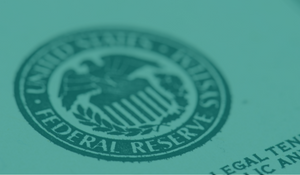Often considered an important indicator of our economic future, the yield curve has experienced a...
The Fed is in the spotlight, and that’s no accident
A break from tradition has led to more transparency, which also means more noise.
The Federal Reserve has been getting a lot of attention lately. Investors, business leaders, and the general public all seem to be hanging on the Fed’s every word. Predictions in the runup to Fed meetings, wild market fluctuations in response to interest rate changes, and tidal waves of analysis in the wake of policy announcements are all evidence that the world is watching more closely than ever, for better or worse.
Indeed, the Fed is a remarkably influential institution and its actions are vital for all of us. As the nation’s central bank, the Fed uses its power over interest rates to influence economic activity and promote a healthy economy. Lately, that’s meant increasing interest rates to slow economic activity and reduce inflation.
The aggressive pace of these rate hikes—the Fed recently raised its target rate by 0.75% for the fourth time in a row—has prompted concern about the near-term vitality of our economy as a whole. That’s because changes in interest rates can influence everything from borrowing costs, to corporate profits, to consumer prices, and even the job market. People have good reason to pay attention.
While fascination with the Fed is hardly new, the recent focus feels more pronounced than in the past. Even Fed actions during the tumult of the Great Recession seem to have made a smaller splash than today. Modern technological shifts like smart phones and social media might seem to be natural explanations for the uptick in publicity, but there’s actually something else going on.
Historically, the Fed’s work has been conducted behind closed doors and its leaders have shied away from public attention. There was an unofficial policy within the Fed to keep communication limited as to avoid speculative reactions from the public that might create turmoil. Former Fed Chair Alan Greenspan once bragged about having used “some form of syntax destruction” in order to avoid answering questions.
But over the last decade, the Fed has adopted a new approach that represents a seismic shift in its communication efforts. In 2012, the Fed issued a largely-unnoticed strategy document in which it stated a new commitment to explaining its decisions with the public as clearly as possible. Such clarity, it says, “facilitates well-informed decision making by households and businesses [and] reduces economic and financial uncertainty.” The strategy was quietly reaffirmed in 2017 and again in 2022 without fanfare.
It doesn’t take a monetary policy expert to see that this policy has both advantages and drawbacks. While increased communication promotes transparency and accountability, it can also create confusion and overreaction when people struggle to process the glut of information that’s now being shared—we’re not all monetary policy experts, which is painfully obvious when watching the wild market swings in the hours after a Fed press conference.
Also, transparency gets dicey when it comes to predictions. And, as part of its new communication policy, the Fed now shares its own expectations about where it thinks interest rates will be in the coming years. These forecasts shed light on the thinking of the Fed in an unprecedented way, but they ought to be published with a warning label—no one has a crystal ball when it comes to the economy, not even the Fed itself!
In fact, Fed leaders’ past projections have proven to be inaccurate as they continue to grapple with new uncertainties just like the rest of us. The expectations they share are interesting and informative in providing context for their current actions, but it would be unwise to take these forecasts as prophecy.
All told, if it feels like we’re hearing more from the Fed these days it’s because we are hearing more from the Fed these days. And with more communication comes more attention, more scrutiny, and more potential reaction (or overreaction) to the information being shared.
In this environment, it’s more important than ever to tune out the daily noise and stay focused on the more predictable long-term potential of the U.S. economy and its capital markets.
-1.png?width=50&name=Untitled%20design%20(32)-1.png)



